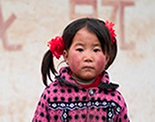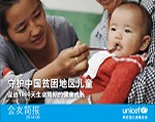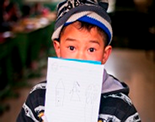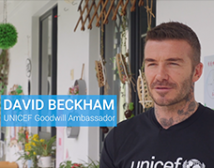China's progress on reducing child mortality highlighted, but reduction slowing down.

Cover photo of the 2008 SWOC report. |
BEIJING, 24 JANUARY 2008 – In a major report released this week, the United Nations Children's Fund (UNICEF), has announced that further reduction in the number of deaths among children under five years of age may be in doubt if life-saving supplies integrated with regular health services are not made available to more children. UNICEF's "State of the World's Children 2008" (SOWC 2008) also emphasized several basic strategies that can help reduce the number of such deaths.
"Simple, affordable, life-saving measures and improvements in national health systems can save many of the more than 26,000 children under five who die around the world each day," said Ann M. Veneman, UNICEF Executive Director, at the Geneva launch of the annual report. "This report describes the impact of interventions such as exclusive breastfeeding, immunization, insecticide-treated bed nets and vitamin A supplementation, all of which have helped to reduce child deaths in recent years. Integrated delivery of these interventions and their promotion or inclusion through routine community health services for mothers and their young children, increases their coverage and likely impact even more."
 ©UNICEF/China/2008 ©UNICEF/China/2008
Dr. Yin Yin Nwe, UNICEF Representative to China addresses the launch |
The report's analysis also suggests that apart from the key interventions listed by Ms. Ann Veneman, action is needed to prevent and treat pneumonia, diarrhoea, malaria, severe malnutrition and HIV infection. It suggests that the challenge is to ensure children have local access to a continuum of health care – a strategy first documented in China's Ding Xian County, Hebei Province in the 1930s - backed by strong national health systems.
The report estimates that globally 9.7 million children die each year, around 415,000 (4.3%) of them in China. China's under five mortality rate has almost halved since 1990, with the majority of deaths now occurring in the first few weeks of life.
UNICEF Representative to China, Dr Yin Yin Nwe, noted today: "The report advocates combining high-impact, disease specific interventions – such as exclusive breastfeeding and vitamin A supplementation - with investment in strong national health systems in order to deliver a continuum of maternal and child health care in the village through local clinics and hospitals."
 ©UNICEF/China/2008 ©UNICEF/China/2008
Dr. Shi Qi from Ministry of Health addresses the launch |
The 2006 Joint Review of the Maternal and Child Survival Strategy in China by the Ministry of Health with support from UNICEF, the World Health Organization and the UN Population Fund also supports the SOWC's main conclusions on key interventions, also noting that progress in reducing child mortality is slowing down. Many of China's remaining preventable young child deaths occur in poor, remote areas where access to and uptake of quality services are lacking. Child mortality rates in remote rural areas are several times higher than those in urban areas. In addition to lack of geographic access, health services are out of reach of poor rural families, and also many migrants in urban areas.
The child health gains China has made since 1990 have been achieved with heavy investment in public health infrastructure, and more recently insurance and financing schemes to increase demand. Since 1978 the number of health facilities in China increased by 82 per cent and the number of health staff by 88 per cent. However, as the Joint Review notes, significant challenges for maternal and child health care remain. Emergency obstetric and newborn care is problematic for populations in remote areas. Newborn mortality, much of it preventable, now amounts to 64 per cent of all under five deaths. Micro-nutrient malnutrition remains a problem with one in ten children suffering from vitamin A deficiency and almost one in five anaemic due to iron deficiency.
Attention broadcasters: Video footage is available free of charge at www.thenewsmarket.com/unicef
UNICEF is on the ground in over 150 countries and territories to help children survive and thrive, from early childhood through adolescence. The world's largest provider of vaccines for developing countries, UNICEF supports child health and nutrition, good water and sanitation, quality basic education for all boys and girls, and the protection of children from violence, exploitation, and AIDS. UNICEF is funded entirely by the voluntary contributions of individuals, businesses, foundations and governments.































